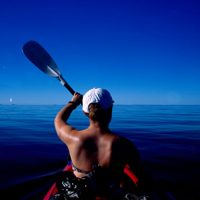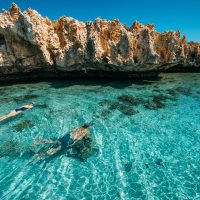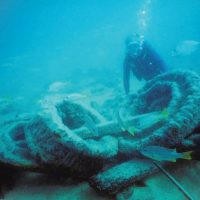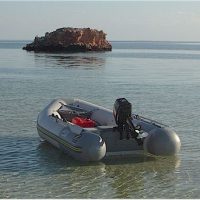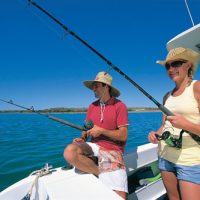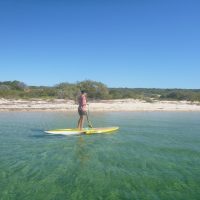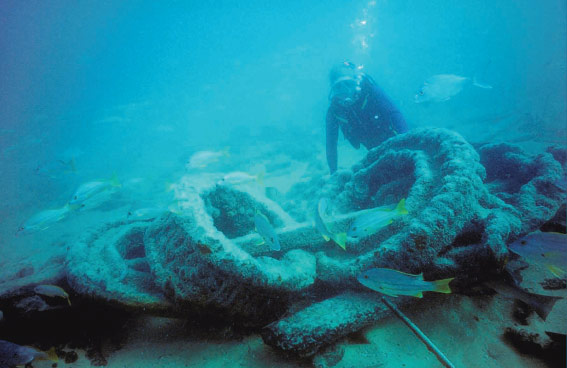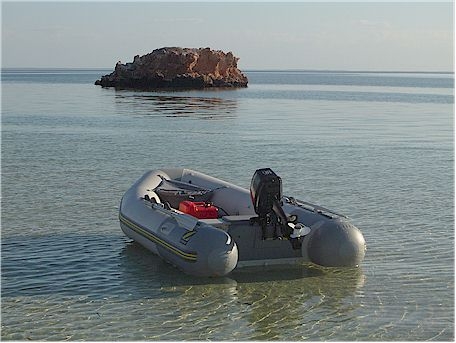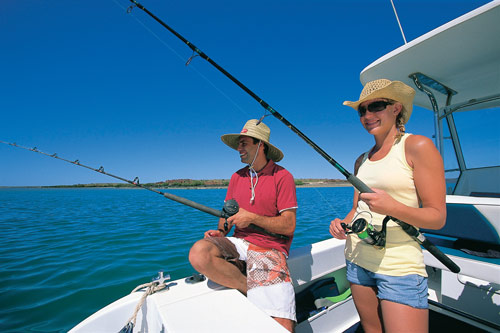Things To Do On Water
Shark Bay has a variety of activities for nature-lovers to enjoy, see below for things to do on water.
The waters of Shark Bay are generally safe for swimming. Despite warm Leeuwin current influences it is quite cool in winter.
Snorkelling & Diving
Shark Bay is not a well-known destination for snorkellers and divers but is a wonderful place to explore the underwater world.
- Eagle Bluff has clear shallow waters (1-5m deep) around the base of the bluff ideal for snorkelers to view marine creatures up close. Enter the water from the beach on the eastern side of the bluff. About 100m from the south-eastern point is a sand patch with a number of coral bombies where sea stars, sea cucumbers and sea urchins hide among the rocks and coral.
- Gregories in Francois Peron National Park has a shallow coral wall just offshore that is perfect for a drift snorkel. The reef is only in 2-3 m water and supports small areas of coral and abundant fish.
- Bottle Bay in Francois Peron National Park has a reef about 2-4m deep and 80m off the beach. It has a small patch of corals and sponges with tropical fish and crustaceans.
- Surf Point is a sanctuary zone at the southern end of Dirk Hartog Island with good coral cover and abundant fish in shallow water.
- Bar Flats is a popular dive and snorkel site accessible by boat. It is 3m deep and abounds in small fish and cabbage, staghorn and soft corals. Yellow tubeworms, sponges, sea anemones and passing dugongs may also be seen.
- Sandy Point is a sanctuary zone on the eastern side of Dirk Hartog Island with some of the best coral Shark Bay.
- Monkey Rock at Steep Point is on a fault line running from Steep Point and is one of Shark Bay’s best known dive sites. It can be reached by boat or from the land but diving should only be attempted in optimum weather conditions and on a slack or incoming tide.
- The wreck of the Gudrun lies in 6 metres of water about 10km north of Cape Peron in a sanctuary zone. It is home to a proliferation of marine life including spotted groper, lionfish, pilotfish, batfish, sweetlip, trevally and mackerel. Divers are welcome to explore the wreck but currents can be dangerous – dive only on a slack, and preferably neap, tide and only with an experienced operator.
Windsurfing & Kite-boarding
Shark Bay has plenty of wind, much to the delight of windsurfers and kite boarders. These activities are becoming increasingly popular with sites like the Denham foreshore, Little Lagoon and Monkey Mia attracting a small band of dedicated boarders when winds are strongest in summer.
Kayaking & Paddling
The large inner gulfs of Shark Bay are almost totally protected from the powerful Indian Ocean swells and are therefore great for sea-kayaking and other paddle craft. The best time of year is during winter when the wind drops.
Paddlers will be rewarded with breath-taking scenery, limestone islands, rich red sand dunes, massive sea grass beds and abundant wildlife. Contact sea-kayak companies in Perth for itineraries that include Shark Bay. If you have your own kayak, discuss trip options with local Parks and Wildlife staff.
Short trips with stand-up paddle-boards, canoes and smaller craft are just as rewarding and make the most of brief wind drops throughout the year.
Fully formed boat ramps suitable for launching large boats are located in Denham, Monkey Mia and Nanga Bay Resort. Small boats can be launched off the beach at Gladstone and Bush Bay on the Wooramel Coast, Shelter Bay near Steep Point and some sites in Francois Peron National Park.
Please Remember
- Strong southerly winds are the norm in summer. Always check local conditions before heading out.
- Generally the waters throughout Shark Bay are shallow so keeled boats have difficulty navigating in many areas.
- Boat access is restricted in certain areas to protect sensitive habitats, breeding populations and other recreational activities.
- Reduce boat speed around dugongs, turtles and whales. Approach dugongs and turtles at slow speed and keep at least 50m away. Stay 100m from whales and do not go within 30 degrees either side of their direction of travel.
- Note the location of seagrass banks and stay away from shallow areas to minimize propeller damage. Seagrasses are the foundations of Shark Bay’s ecosystems and, once removed, can take decades to recover.
- Anchors cause severe damage to coral and seagrass and should not be used. Anchor only in bare sand.
- Shark Bay is rich in bird life, including migratory and breeding seabirds. It is also Australia’s most important nesting area for loggerhead turtles. Observe and conserve – do not disturb nesting turtles and seabird colonies.
Shark Bay is one of Western Australia’s most popular recreational fishing destinations for small boat and shore-based anglers.
The Department of Fisheries and the Parks and Wildlife Service have regulations and marine zones in place that you must be aware of when boating and fishing.
Shark Bay Marine Park encompasses most of Shark Bay but there are only a few areas where line fishing is prohibited. These are Hamelin Pool Marine Nature Reserve and the sanctuary zones – 18 Mile Beach, Mary Anne Island, Gudrun Wreck, Surf Point, Sandy Point, Big Lagoon, Disappointment Reach and L’haridon Bight.
See the download the Shark Bay marine reserves brochure to find out what activities are allowed in the different marine park zones.
A fishing licence is required when fishing from a boat.
Steep Point & False Entrance
Opportunities to fish from cliffs for mackerel and other pelagic species attract hard core anglers with special equipment to Steep Point. Helium balloons are used to float bait offshore and special gaffs are required to haul fish up the cliff face. Late summer is the best time for catching pelagic species from the cliffs. Campsites are in high demand during this time so book ahead.
Further south is False Entrance where anglers also fish from cliffs for mackerel and other pelagic species. The jagged limestone rock in this area is hard on footwear and bare foot fishing is not recommended. There are informal campsites near the beach.
As with the sites around Steep Point, high clearance 4WD is essential to access this area and camping permits must be obtained in advance.
Dirk Hartog Island
The western side of Dirk Hartog Island is similar to Steep Point with anglers risking cliff fishing for pelagic species like tuna, mackerel and kingfish. The warm Leeuwin current from the north can also bring gamefish like marlin and sailfish close to shore.
The eastern side is great for land based fishing catches including tailor, flathead and giant trevally.
Francois Peron National Park
This popular destination has easy access to a number of quiet coastal campsites and less demanding shore-based fishing. With relatively little effort you can catch a feed of whiting, flathead or tailor from the beaches. Access these sites is by high clearance 4WD only and you will need a high clearance trailer if taking a small dinghy.
Monkey Mia
Fishing is possible in the waters off Monkey Mia and from the beach areas adjacent to the resort. Although the water is generally shallow it is possible to catch some of the inshore species like whiting and flathead. Fishing is not permitted within the dolphin experience area.
Fish for the future – take only what you need. Observe possession limits. Quickly return undersize and unwanted fish to the water. Discard all rubbish and fishing line in bins when ashore.
Bag and Possession Limits
Special bag and possession limits are in place to manage Shark Bay fish stocks. For example, in the inner gulfs it is illegal to fillet fish at sea; only whole fish can be brought ashore. Visit the Department of Fisheries for details.
Shark Bay Marine Park Zones
Shark Bay Marine Park protects Shark Bay’s rich marine life while allowing public enjoyment of the region. The regulations in the marine park zoning system manage local marine ecosystems to protect fish stocks, dugong habitat, seagrass meadows and stromatolites. See the Shark Bay Marine Reserves brochure for details.
Fisheries Zones & Pink Snapper Regulations
Over and above the marine park zoning system there are special zones in place to better manage the local pink snapper population. Pink snapper stocks in the inner gulfs of Shark Bay are vulnerable to overfishing and were badly depleted at one stage. Visit the Department of Fisheries for details.
Department of Biodiversity, Conservation and Attractions
Gascoyne District Office
63 Knight Terrace
Denham WA 6537
Ph: +61 8 9948 2226
Fax: +61 8 9948 1024
Email: gascoyne@dbca.wa.gov.au
Department of Fisheries
Shark Bay Office
61 Knight Terrace
Denham WA 6537
Ph: +61 8 9948 1210
Fax: +61 8 9948 1154
http://www.fish.wa.gov.au/


